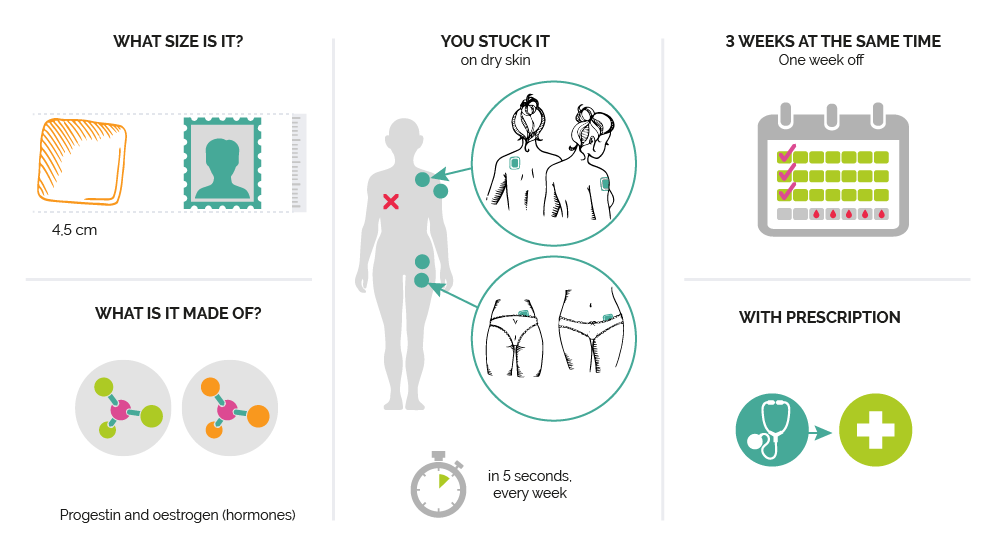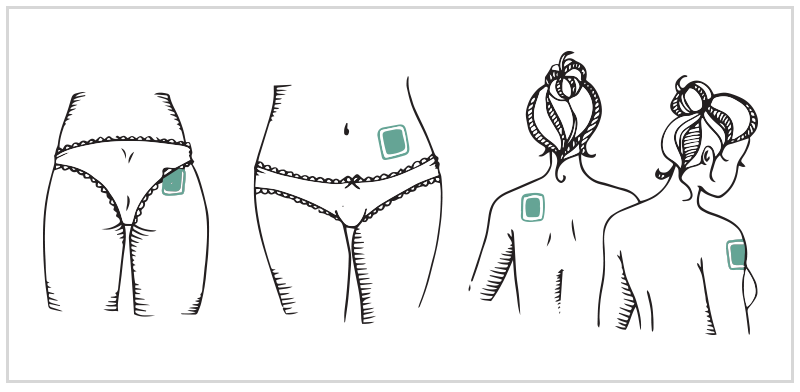THE HORMONAL PATCH
Also known as the contraceptive patch, it is stuck on the skin every week for three weeks.
* Practical effectiveness: when measured under conditions of current use (taking into account omissions, failures, etc.)
** Theoretical effectiveness: when observed under conditions of perfect use (without problems of use and without interaction with other medicine)
Source: effectiveness percentages are taken from WHO (2018)
HOW DOES IT WORK?
It is a patch which is stuck on the skin and replaced every week. Each patch diffuses a combination of hormones for a week, which pass through the skin and end up directly into the bloodstream. The patch blocks ovulation, thickens the cervical mucus (which makes it harder for sperm to pass through) and prevents the lining of the uterus from developing to accommodate a possible fertilized egg. After 3 weeks, you make a one-week break which will trigger your period.
INTERESTING FIGURES AND DETAILS

HOW TO USE IT?

STEP 1
Go to a physician or gynaecologist and then to a pharmacy with your prescription
STEP 2
Is it the first time you use hormonal patches? Or maybe you are starting to use it again after a break? Stick the first patch on the first day of your period.
You would like to start using hormonal patches immediately ? There are certain conditions to respect. Ask your physician for more information.
STEP 3
Remove the patch from the package (keep the package for later). Stick the patch on a clean, dry and wound-free area: the abdomen, the upper arm, or the buttock. Do not stick-on breasts nor on a part that can be exposed to the sun. Do not use skin care products around the patch.
STEP 4
Let it in place for a week. Change it after 7 days at about the same time of day. Stick the new patch in a different area than the previous one to avoid skin irritation. Put the used patch in its original packaging and then, in the garbage.
STEP 5
After sticking the 3rd patch, wait the normal 7 days, remove the patch and do not stick another one for 7 days. This will trigger your period. Put the used patch in its original packaging and then, in the garbage.
STEP 6
After 7 days of period, stick a new patch at a different area than the previous one.
It is possible to delay your period by sticking a new patch without a break.
WHERE TO GET IT?
Starting 1 April 2023, this contraceptive is delivered free of charge on medical prescription in any Luxembourg pharmacy to people affiliated with the National Health Fund, with no age limit.
For more information: click here.
This contraceptive can also be delivered for free at the Family Planning, including to people not covered by National Health Fund.
Contraceptive patches cost on average 144€* per year (13 cycles, for a total of 39 patches).
*(This price is an average indication which may vary)
ADVANTAGES
- The contraceptive patch is a reliable contraceptive method
- It allows to delay or stop your period
- It is easy to stick
- It allows regular period
- You do not have to think about it at every sexual intercourse
- Protects against an unwanted pregnancy, even in case of vomiting and/or diarrhea since hormones are not passing through the digestive system.
Bon à savoir
- The contraceptive patch does not protect against sexually transmitted infections. Therefore, remember to use condoms.
- The patch may come off without you noticing it. You can stick it back or put on another one within 24 hours.
- It is important to remember to do this every week, at the right time.
- With a combined hormonal contraceptive (like the patch), there is a greater risk of getting a venous thrombosis. This is a clot formation in the veins that can be dangerous. This risk is higher during the first year of using the contraceptive and when you take it back after a break of more than 4 weeks.
- You should first consult your physician to obtain a prescription. Because it is a combined contraceptive method, the physician checks to see if you are at risk of getting a thrombosis.
- Effectiveness decreases if you weigh more than 90 kg.
- It is not recommended to use the contraceptive patch if you are breastfeeding. Instead, use a method that does not contain oestrogen, such as the Minipill, the implant, the contraceptive injection, or the IUD (hormonal or copper).

QUESTIONS fréquentes
When is the patch effective after it has been applied?
If the patch is applied within the first 5 days of the period, it is effective immediately.
However, if it is applied at any other time in the cycle, it is necessary to use additional contraception for 7 days after the patch is applied. In other words, you must wait until the 2nd patch is applied before having intercourse without additional contraception.
If you have any questions, please refer to the patch instruction or talk to your physician.
Can I bathe or go to spas and saunas with the patch?
The patch is designed to withstand this kind of activity and adheres well to the skin. You can therefore continue with your normal daily activities, such as showering, bathing, etc. However, it is important not to apply any cream, oil, lotion, powder or make-up around the patch, as this may reduce its effectiveness (it may come off).
Can I get a tan with the patch?
It is perfectly possible to tan with the patch, however, without exposing it to the sun. As heat is responsible for the deployment of hormones, prolonged exposure to the sun may alter the effectiveness of the patch.
Is it possible to avoid having my period with the patch ?
Yes. When you remove your 3rd patch of the month (after 3 weeks), it is possible to put one back on immediately for another 7 days and avoid having your period. This is not dangerous or bad for your health. If you want to use a contraceptive method that allows you to avoid having your period, talk to your physician, there are solutions!
Is having my period a proof that I am not pregnant?
No. If you use the patch, you can have your period while you are pregnant. In fact, with hormonal contraception such as the patch, the bleeding is called “withdrawal bleeding”. They are therefore not real periods. Menstruations on hormonal contraception are not a reliable indicator of whether or not you are pregnant.
If you forgot to put on or change a patch, or it has come off, you can find information below or talk to a health professional.
The only reliable way to ensure that you are not pregnant is to take a pregnancy test. Please note that a pregnancy test is only reliable 19 days after unprotected sex.
What should I do if I notice that the patch has partially or completely come off?
If it has been less than 24 hours, try to stick it again or use a new one. Stick the next patch on the original date planned for changing your patch.
If it has been more than 24 hours, apply a new patch. This new patch will be the first of a new cycle of 3 patches. In order to maintain your contraceptive coverage, it is important to use additional contraception (e.g. condoms) for the first 7 days after applying the new patch.
I forgot to change my patch after 7 days, what should I do?
- If you forgot to stick the 2nd patch on: If you kept the first patch, it can protect you from pregnancy for up to 9 days. If you are less than 48 hours late, simply apply the 2nd patch, then apply the 3e patch on the day it was originally scheduled (even if this means sticking the 2nd patch for only 5 days). You do not need to use any additional contraception.
- If you forgot to stick the 3rd patch on: If you kept the 2nd patch, it can protect you from pregnancy for up to 9 days. If you are less than 48 hours late, simply apply the 3rd patch and then remove it on the date your period was originally due (even if this means sticking the 3rd patch for only 5 days). You do not need to use any additional contraception.
- If you have forgotten to replace a patch more than 48 hours late AND you had unprotected sex in the previous 5 days, it is recommended that you take emergency contraception and consult a health professional, as there is a risk of pregnancy.
I forgot to take off my 3rd patch to have my period, what should I do?
Remove the patch as soon as you realize that you have forgotten and start a new 4-week cycle on the originally scheduled date. There is no need to use additional contraception during this period.
However, if you have forgotten to remove the patch for more than a week AND you had unprotected sex in the last 5 days, it is recommended that you take emergency contraception and consult a health professional, as there is a risk of pregnancy.
I forgot to reapply a patch after the 7-day period, what should I do?
Put on a new patch as soon as possible. If you had sex in the last 5 days, it is advisable to take emergency contraception as soon as possible and to consult a health professional, as there is a risk of pregnancy.
Where and how do I dispose of my patch?
In order to respect the environment, it is important not to throw your used patches in the garbage. The patches still contain a certain amount of active hormonal substances when they are removed, so the patch should be folded in half on the self-adhesive side. Then put the folded patch back into the original packaging. You can return your used patches to your pharmacy, or find out about collection points for old medicines at www.sdk.lu.
Can I use the patch if I weigh more than 90 kg?
If you weigh more than 90 kg or have a body mass index (BMI) above 30, the patch may be less effective. Discuss this with your physician or gynaecologist.
Can I stick the patch on my breast?
It is not recommended to stick it on your breast, neither on cuts or on red or irritated skin. We advise you to stick it on the buttocks, the lower abdomen, the outside of the upper arm or the upper back (behind the shoulder). Make sure to change the area of the body every week.



